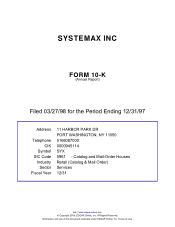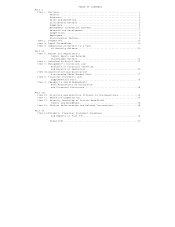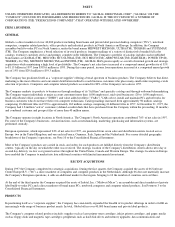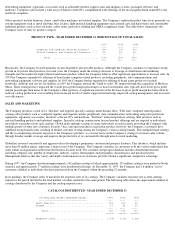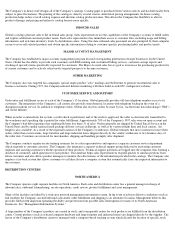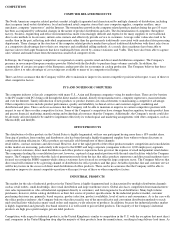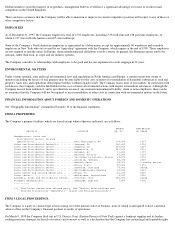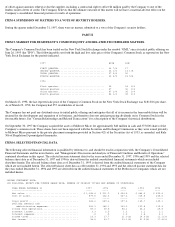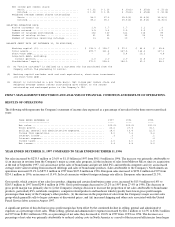Circuit City 1997 Annual Report Download - page 8
Download and view the complete annual report
Please find page 8 of the 1997 Circuit City annual report below. You can navigate through the pages in the report by either clicking on the pages listed below, or by using the keyword search tool below to find specific information within the annual report.COMPETITION
COMPUTER RELATED PRODUCTS
The North American computer related products market is highly fragmented and characterized by multiple channels of distribution, including
direct response (mail order) distributors, local and national retail computer stores that carry computer supplies, computer resellers, mass
merchants, computer "superstores" and the Internet. The tremendous growth in the computer related products market during the past 10 years
has been accompanied by substantial changes in the nature of product distribution and sales. The decentralization of computers throughout
factory, business, engineering and office environments has made it increasingly difficult and expensive for many suppliers to use traditional
direct sales methods to locate users, initiate sales contacts and effectively provide service to customers. Average order values also tend to be
smaller than in the past, reflecting individual requirements rather than the greater needs traditionally associated with centralized data processing
departments. These changes in the structure of the computer related products market have placed traditional distributors with direct sales forces
at a competitive disadvantage due to their cost structures and established selling methods. As a result, direct marketers have been able to
increase sales to the larger businesses that have traditionally been served by contract stationers and VARs. They have also been able to capture
sales volume and market share from the numerous small retail computer stores.
In Europe, the Company's major competitors are regional or country-specific retail and direct-mail distribution companies. The Company's
presence in seven major European countries provides Global with the flexibility to purchase large volumes centrally. In addition, the
commonality of certain core pages of the European catalogs provides for economies in catalog production. The Company believes that these
factors allow it to take advantage of cost savings not available to many of its competitors in Europe.
There can be no assurance that the Company will be able to maintain or improve its current competitive position with respect to any of these or
other competitive factors.
PCS AND NOTEBOOK COMPUTERS
The computer industry is fiercely competitive with many U.S., Asian and European companies vying for market share. There are few barriers
to the PC market with PCs being sold through the direct market channel, directly from manufacturers, computer superstores, mass merchants
and over the Internet. Timely introduction of new products or product features are critical elements to maintaining a competitive advantage.
Other competitive factors include product performance, quality and reliability, technical service and customer support, marketing and
distribution and price. There can be no assurance that the Company will be able to maintain or improve its current competitive position with
respect to any of these or other competitive factors. Some of the Company's competitors have stronger brand-
recognition, broader product lines
and greater financial, marketing, manufacturing and technological resources than the Company. Additionally, the Company's results could also
be adversely affected should it be unable to implement effectively its technological and marketing arrangements with other companies, such as
Microsoft(R) and Intel(R).
OFFICE PRODUCTS
The distribution of office products in the United States is highly fragmented, with no one participant having more than a 10% market share.
Sourcing of products from vendors and distributors also has been through a highly-fragmented supplier base without volume discounts or
central purchasing efficiencies. Office products are typically sold through one of three channels:
retail outlets, contract stationers and direct mail. However, due to the rapid growth of the office products market, competition and consolidation
in this market are increasing, particularly with respect to the SOHO and large corporate (companies with over 1,000 employees) segments.
Large contract stationers, direct mail distributors and office products superstores have grown at the expense of small independent retail dealers.
The companies leading this consolidation have not, however, captured a large market position with the mid-sized facilities which the Company
targets. The Company believes that this lack of penetration results from the fact that office products superstores and direct mail marketers have
focused on serving the SOHO segment while contract stationers have focused on serving the large corporate sector. The Company believes that
direct mail will continue to be a growing channel of distribution for office products and that price, breadth of product line and customer service
will be key factors in the success of direct mail distribution of office products. There can be no assurance that the Company will be able to
maintain or improve its current competitive position with respect to any of these or other competitive factors.
INDUSTRIAL PRODUCTS
The market for the sale of industrial products in the United States is highly fragmented and is characterized by multiple distribution channels
such as retail outlets, small dealerships, direct mail distribution and large warehouse stores. Global also faces competition from manufacturers'
own sales representatives who sell industrial equipment directly to customers, and from regional or local distributors. Many high volume
purchasers, however, utilize catalog distributors as their first source of product specifications. In the industrial products market, customer
purchasing decisions are, primarily, based on price, product selection, product availability, level of service and convenience. As is the case with
the office products industry, the Company believes that direct mail is one of the most effective and convenient distribution methods to reach
mid-sized facilities which place many small orders and require a wide selection of products. In addition, because the industrial product market
is highly fragmented and generally less brand oriented, it is well suited to private label products. The majority of the Company's industrial
products are high gross profit margin, private label products.
Competition, with respect to industrial products, in the United Kingdom is similar to competition in the U.S. with the exception that most direct
mail companies in the United Kingdom drop ship the majority of their products from the manufacturer, resulting in long delivery lead times. As

